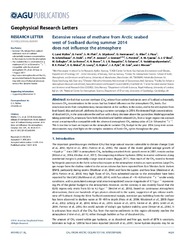Extensive release of methane from Arctic seabed west of Svalbard during summer 2014 does not influence the atmosphere
Permanent lenke
https://hdl.handle.net/10037/9519Dato
2016-05-07Type
Journal articleTidsskriftartikkel
Peer reviewed
Forfatter
Myhre, Cathrine Lund; Ferré, Benedicte; Platt, Stephen Matthew; Silyakova, Anna; Hermansen, Ove; Allen, Grant; Pisso, Ignacio; Schmidbauer, Josef Norbert; Stohl, Andreas; Pitt, Joseph R.; Jansson, Pær; Greinert, Jens; Percival, Carl; Fjæraa, Ann Mari; O'Shea, Sebastian J.; Gallagher, Martin; Le Breton, Michael; Bower, Keith N.; Bauguitte, Stéphane Jean-Bernard; Dalsøren, Stig Bjørløw; Vadakkepuliyambatta, Sunil; Fisher, Rebecca E.; Nisbet, Euan G.; Lowry, David; Myhre, Gunnar; Pyle, John Adrian; Cain, Michelle; Mienert, JurgenSammendrag
We find that summer methane (CH4) release from seabed sediments west of Svalbard substantially increases CH4 concentrations in the ocean but has limited influence on the atmospheric CH4 levels. Our conclusion stems from complementary measurements at the seafloor, in the ocean, and in the atmosphere from land-based, ship and aircraft platforms during a summer campaign in 2014. We detected high concentrations of dissolved CH4 in the ocean above the seafloor with a sharp decrease above the pycnocline. Model approaches taking potential CH4 emissions from both dissolved and bubble-released CH4 from a larger region into account reveal a maximum flux compatible with the observed atmospheric CH4 mixing ratios of 2.4–3.8 nmol m−2 s−1. This is too low to have an impact on the atmospheric summer CH4 budget in the year 2014. Long-term ocean observatories may shed light on the complex variations of Arctic CH4 cycles throughout the year.
Beskrivelse
Publisher's version, source http://doi.org/10.1002/2016GL068999


 English
English norsk
norsk